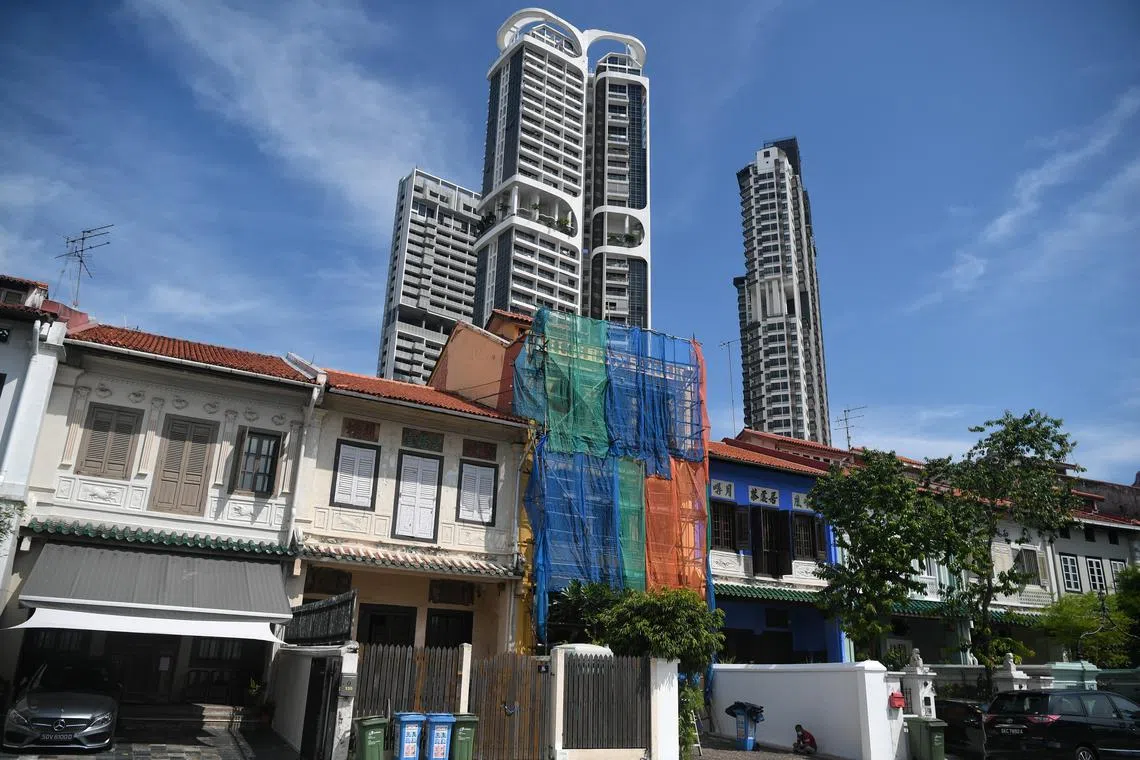Public can observe restoration work up close in conserved 1880s house from 2023
Sign up now: Get ST's newsletters delivered to your inbox

The restoration of 141 Neil Road (second from left) will provide students and researchers from NUS with learning and research opportunities.
PHOTO: ST FILE
Follow topic:
SINGAPORE - From early 2023, the public can observe restoration work up close in a conserved townhouse and learn about how conservators bring back the lustre of Singapore’s heritage buildings.
The restoration of 141 Neil Road, an 1880s house in the Blair Plain conservation area, will also provide students and researchers from the National University of Singapore (NUS) with learning and research opportunities.
On Monday, the university’s Department of Architecture, which comes under the NUS College of Design and Engineering, opened the Architectural Conservation Laboratory (ArClab), an educational centre that will be housed in the conserved building.
The building was donated to NUS by the Portabella family, along with a gift of $2 million to support repair and conservation works, which will take place over five years and be completed in 2027.
A fourth-generation member of the family, Mr Ricardo Jr Portabella, said his family has been investing in properties in Singapore since 2008, and currently has 13 shophouses in their portfolio.
Mr Portabella, 25, said his family acquired the Neil Road townhouse in March 2020 with the intention of donating it towards research that would improve local knowledge and expertise in maintaining and conserving shophouses.
“It was like a blank canvas, with no inhabitants for more than a decade, and we thought it was a good opportunity for contractors and architects to try out new techniques,” he added.
In a statement, NUS said that by using the conserved townhouse as a laboratory, ArClab will contribute towards building professional capacity in the management of historical resources, and promoting historical and environmental studies.
Established in January, ArClab aims to increase local training capabilities and research in building conservation, apply technology in conservation works, and promote building retrofits that will make them carbon and energy neutral.

National Development Minister Desmond Lee (left) and Mr Ricardo Jr Portabella (second from left) are led on a tour of 141 Neil Road by Professor Ho Puay Peng, head of the NUS Department of Architecture and Unesco chair on Architectural Heritage Conservation and Management in Asia.
PHOTO: Lianhe Zaobao
Speaking at the laboratory’s opening on Monday, National Development Minister Desmond Lee noted that Singapore has for many years learnt from global best practices and relied on skilled foreigners for restoration expertise.
“Moving forward, we would like to push ourselves further and elevate the conservation landscape in Singapore,” he said, adding that one way is to further develop the skill sets of local built heritage professionals.
“After all, it is the local architects, designers, engineers and members of the built environment sector who understand well Singapore’s unique values and history, and – working together with our friends and counterparts from around the world – are able to translate these into our conservation efforts.”
Mr Lee added that these specialists will not only be vital to the technical restoration of conserved and heritage buildings but also to their long-term management and value to the community.
Through the restoration of 141 Neil Road, NUS will facilitate graduate and postgraduate studies of built heritage, and provide advanced courses for built heritage professionals.
Mr Lee said he hopes ArClab will also kick-start more conversations on the future of the built and cultural heritage in Singapore, and foster appreciation for the nation’s built heritage among the public and potentially inspire future leaders in this area.
NUS said that 141 Neil Road is among the oldest buildings in Neil Road, having been built as part of the Everton estate in the 1880s. It occupies a land area of about 296 sq m and has a gross floor area of 447 sq m over two floors and an attic.
Professor Ho Puay Peng, who heads the NUS Department of Architecture, said that besides technical conservation research, research into the house could also yield new understandings about social patterns in Singapore.
“We talk about kampung spirit, but we never talk about shophouse spirit or townhouse spirit,” said Prof Ho, adding that there is scope for research on the relationships within shophouse communities, which began in the mid-1800s.
NUS College of Design and Engineering deputy dean for research Heng Chye Kiang noted that many of Singapore’s conserved properties – more than 7,200 buildings and structures are conserved – have been retrofitted with air-conditioners, which has “jacked up carbon emissions tremendously”.
Professor Heng added that cooling buildings could also have done unintended damage to them over the years, and hopes that through ArClab, architects, designers and engineers will be able to devise cooling solutions that “are a lot more sustainable, a lot more carbon sensible”.


